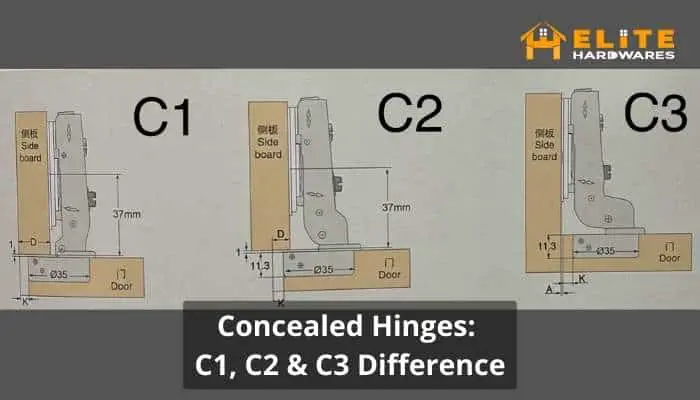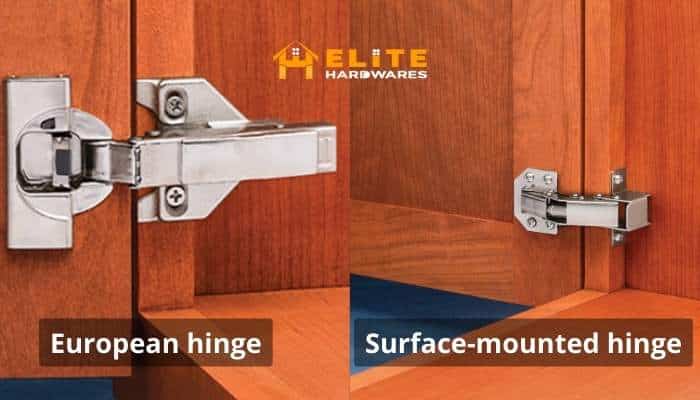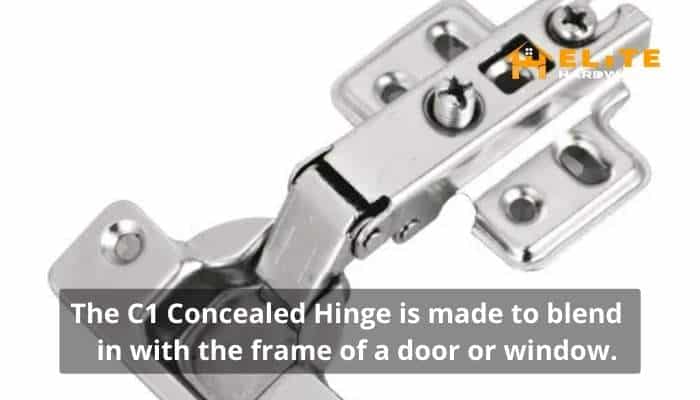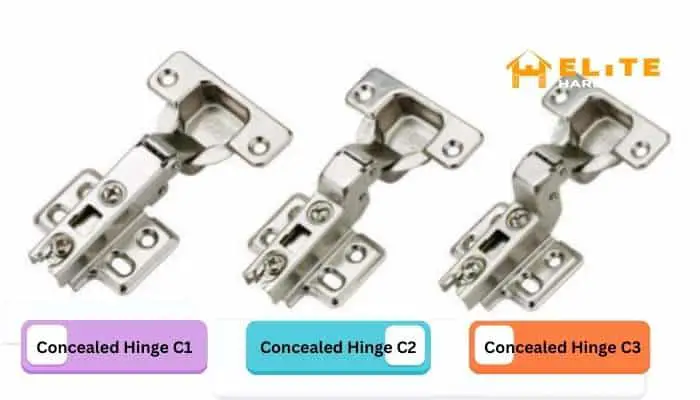Concealed Hinges: C1, C2 & C3 Difference | Which One Is Best for Your Use?
If you’re in the process of selecting concealed hinges for your cabinetry, you’ve probably noticed that there are three main types: C1, C2, and C3. But what are the concealed hinges c1, c2 & c3 differences? And how do you know which one is right for your project?
Concealed hinges are classified according to the door size they’re designed to support. C1 hinges are the smallest and are typically used on doors that are up to 30” wide. C2 hinges are medium-sized and can support doors up to 40” wide. C3 hinges are the largest and can be used on doors up to 60” wide.
So, if you’re unsure which concealed hinge to choose for your project, the first thing you need to do is determine the door size. Once you know that, selecting the right hinge will be a breeze!

What Are the Different Types of Concealed Hinges?
Concealed hinges are a type of door hinge that is not visible when the door is closed. They are often used in cabinet doors and other applications where a traditional door hinge would be visible. There are several different types of concealed hinges, each with its own advantages and disadvantages.

The most common type of concealed hinge is the European hinge. These hinges are very strong and allow for a wide range of motion, making them ideal for heavy doors. However, they can be difficult to install and are not always compatible with all types of doors.
Another type of concealed hinge is the surface-mounted hinge. These hinges are easier to install than European hinges, but they are not as strong. They are also not as wide-ranging in their motion, so they may not be suitable for all types of doors.
There are different types of hidden cabinet hinges you can use for a suitable door.
Additional Read: 8 Best Soft Close Cabinet Hinges in 2022 | Top Picks & Reviews.
What Is C1 Concealed Hinge?

C1 Concealed Hinge is a type of hinge that is used in a variety of applications. It is a specialized hinge that is designed to be concealed within a door or window frame. This makes it ideal for using in areas where a traditional hinge would be visible, such as flush doors or applications where a clean, minimalist look is desired.
C1 Concealed Hinges are also used in applications where security is a concern, as they are much more difficult to tamper with than traditional hinges. Also same as C1, there are two more concealed hinges, one is C2 another one is C3. The use of them is based on the size of the door.
Difference Between C1, C2 & C3

As a prospective buyer of concealed hinges, you will come across three classes – C1, C2, and C3. It’s important to understand the difference between these classes, as each has its own benefits and drawbacks. Here, we explain the key differences between C1, C2, and C3 concealed hinges and how to tell them apart.
| Context | Concealed Hinge C1 | Concealed Hinge C2 | Concealed Hinge C3 |
| Definition | These are the most basic type of concealed hinge, and are typically used for light doors such as those found in cabinets. They can also be used for heavy doors, but this will require additional hardware. | C2 hinges, similar to C1 hinges, but they are slightly stronger and can support heavier doors. | C3 hinges are the strongest type of concealed hinge and can support very heavy doors. |
| Footprint | Have a small footprint | Have a larger footprint | Have the largest footprint |
| Adjustability | Not adjustable | Adjustable | Adjustable |
| Known As | Full Overlay Concealed Hinge | Half Overlay Concealed Hinge | Inset Concealed Hinge |
| Usage | Cabinets with doors positioned in front of the cabinet box or frame often employ this hinge. When the door is closed, the cabinet panels’ edge is pressed against the rear of the door’s perimeter. | With the help of this hinge layout, the two doors can share the permitted overlay from the thickness of the cabinet panel. | Doors with concealed inset hinges are recessed into the cabinet panel or frame. As a result, the installation lacks an overlay. |
Additional Read: How to Install Strap Hinges on a Chest? Easy Way.
How Do You Know Which Concealed Hinge Is Right for Your Project?
There are many factors to consider when choosing the right concealed hinges for your project. Here are a few things to keep in mind:
- Size of the door or opening
- Weight of the door
- Finish of the hinges
- Mounting type
Once you have considered all of these factors, you will be able to narrow down your choices and find the right hinges for your project. If you want, you can install no bore concealed hinge for more reliability.
Frequently Asked Question
What is the largest size hinge that can be used?
If you’re looking for concealed hinges, you’ll first want to determine the size of the door you’re working with. C1 hinges are the smallest and are typically used on doors that are up to 30” wide, while C2 is used on 40”. If you need to use a concealed hinge on a door that is 60 inches wide, then you would need to choose a C3 hinge.
What is the difference between a full overlay and a half overlay hinge?
A difference between full overlay and half overlay hinges is that the full overlay hinge has a larger opening than the half overlay hinge. This allows for a greater range of motion and a more secure connection between the door and the hinges. The half overlay hinge is typically used indoors that are less heavy or where a smaller opening is needed.
Final Words
Once you got a clear understanding on concealed hinges c1, c2 & c3 differences, it becomes easy to make the decision which one is best for your project.
Concealed hinges are a great option for a variety of applications. The three main types – C1, C2, and C3 – each have their own benefits and drawbacks. C1 hinges are the most versatile, while C3 hinges are the strongest. C2 hinges offer a balance of both. Ultimately, your project’s best type of hinge will depend on your specific needs and requirements.





